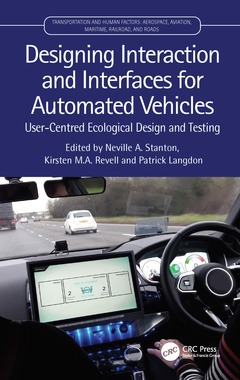Designing Interaction and Interfaces for Automated Vehicles User-Centred Ecological Design and Testing Transportation Human Factors Series

Driving automation and autonomy are already upon us and the problems that were predicted twenty years ago are beginning to appear. These problems include shortfalls in expected benefits, equipment unreliability, driver skill fade, and error-inducing equipment designs. Designing Interaction and Interfaces for Automated Vehicles: User-Centred Ecological Design and Testing investigates the difficult problem of how to interface drivers with automated vehicles by offering an inclusive, human-centred design process that focusses on human variability and capability in interaction with interfaces.
This book introduces a novel method that combines both systems thinking and inclusive user-centred design. It models driver interaction, provides design specifications, concept designs, and the results of studies in simulators on the test track, and in road going vehicles.
This book is for designers of systems interfaces, interactions, UX, Human Factors and Ergonomics researchers and practitioners involved with systems engineering and automotive academics._
"In this book, Prof Stanton and colleagues show how Human Factors methods can be applied to the tricky problem of interfacing human drivers with vehicle automation. They have developed an approach to designing the human-automation interaction for the handovers between the driver and the vehicle. This approach has been tested in driving simulators and, most interestingly, in real vehicles on British motorways. The approach, called User-Centred Ecological Interface Design, has been validated against driver behaviour and used to support their ongoing work on vehicle automation. I highly recommend this book for anyone interested, or involved, in designing human-automation interaction in vehicles and beyond."
Professor Michael A. Regan, University of NSW Sydney, AUSTRALIA
Chapter 1. UCEID - The Best of Both Worlds: Combining Ecological Interface Design with User Centred Design in a Novel Human Factors Method Applied to Automated Driving
Chapter 2. Using UCEID to Include the Excluded: An Autonomous Vehicle HMI Inclusive Design Case Study
Chapter 3. Designing Autonomy in Cars: A Survey and Two Focus Groups on Driving Habits of an Inclusive User Group, and Group Attitudes Towards Autonomous Cars
Chapter 4.An Evaluation of Inclusive Dialogue-Based Interfaces for the Takeover of Control in Autonomous Cars
Chapter 5.The Design of Takeover Requests in Autonomous Vehicles: Low-fidelity Studies
Chapter 6. How Was It for You? Comparing How Different Levels of Multimodal Situation Awareness Feedback Are Experienced by Human Agents During Transfer of Control of the Driving Task in a Semi-Autonomous Vehicle
Chapter 7. Human Driver Post-Takeover Driving Performance in Highly Automated Vehicles
Chapter 8.Validating Operator Event Sequence Diagrams: The Case of Automated Vehicle to Human Driver Takeovers
Chapter 9. Breaking the Cycle of Frustration: Applying Neisser’s Perceptual Cycle Model to Drivers of Semi-Autonomous Vehicles.
Chapter 10. Semi-Automated Driving Has Higher Workload and Is Less Acceptable to Drivers Than Manual Vehicles: An On-Road Comparison of Three Contemporary SAE Level 2 Vehicles
Chapter 11. The Iconography of Vehicle Automation - A Focus Group Study
Chapter 12. Customisation of Takeover Guidance in Semi-Autonomous Vehicles
Chapter 13.The Effects of Interface Customisation on Drivers’ Takeover Experience in Highly Automated Driving
Chapter 14.Accommodating Drivers’ Preferences Using a Customised Takeover Interface
Chapter 15.Modelling Automation-Human Driver Interactions in Vehicle Takeovers Using OESDs
Chapter 16.Feedback in Highly Automated Vehicles: What Do Drivers Rely on in Simulated and Real-World Environments?
Chapter 17. Can Allowing Interface Customisation Increase Driver Confidence and Safety Levels in Automated Vehicle TORs?
Chapter 18. The Effects of Customisable HMI on Subjective Evaluation of Takeover Experience on the Road
Chapter 19.Accommodating Drivers’ Preferences Using a Customised Takeover Interface on UK Motorways
Chapter 20.Validating OESDs in an On-Road Study of Semi-Automated Vehicle to Human Driver Takeovers
Chapter 21.Design Constraints and Guidelines for the automation-human interface
Neville A. Stanton PhD, DSc, is a Chartered Psychologist, Chartered Ergonomist and Chartered Engineer. He holds the Chair in Human Factors Engineering in the Faculty of Engineering and the Environment at the University of Southampton in the UK. He has degrees in Occupational Psychology, Applied Psychology and Human Factors Engineering and has worked at the Universities of Aston, Brunel, Cornell and MIT. His research interests include modelling, predicting, analysing and evaluating human performance in systems as well as designing the interfaces and interaction between humans and technology.
Kirsten Revell PhD, is a Human Factors Engineering Research Fellow at the Faculty of Engineering and the Environment at the University of Southampton in the UK. She has degrees in Psychology, Industrial Design and Human Factors Engineering and has worked in Industry at Microsoft Ltd. as well as within academia at Brunel University London and the University of Southampton. Kirsten’s research interests is understanding how the design of tools and interfaces within their broader systems of use impact user capability and behavior.
Pat Langdon is a Reader (PRA) Computer Engineering (EECE) at the University Cambridge Engineering Department and Principal Research Associate in the Engineering Design Centre; Lead researcher in Inclusive Design. His past research has examined the psychological reality of certain Artificial Intelligence-based theories of Computer Vision and Neural-Network algorithms for robot control as well as Computational support for Engineering Design. He is currently working in the areas of modelling inclusive interaction, particularly vision, learning, movement and cognition for inclusive design and computer assistance for motion impaired interface use. Pat is author and lead researcher responsible for a number of projects including Human Machine Interfaces as applied to Automotive displays and controls using signal processing for gestural and pointin
Date de parution : 03-2021
15.6x23.4 cm
Mots-clés :
Perceptual Cycle Model; UCEID; UK Motorway; User-Centered Ecological Interface Design; AWD; Cognitive Work Analysis; NASA Task Load Index; OESDs; Automated Vehicles; Operator Event Sequence Diagrams; Situation Awareness; Human Factors; Semi-autonomous Vehicles; driver interaction; Driving Simulator; user-centred design; Autonomous Vehicle; design specifications; Cognitive Loading Task; test track studies; Wilcoxon Signed Rank Test; Inclusive Design; Takeover Process; Secondary Task; Instrument Cluster; Centre Console; Steering Angle; Human Factors Methods; UK Driver; Human Driver; Correct Rejections; Customisation Settings; Advanced Driver Assistance Systems; Non-driving Tasks; Cognitive Work Analysis Framework



